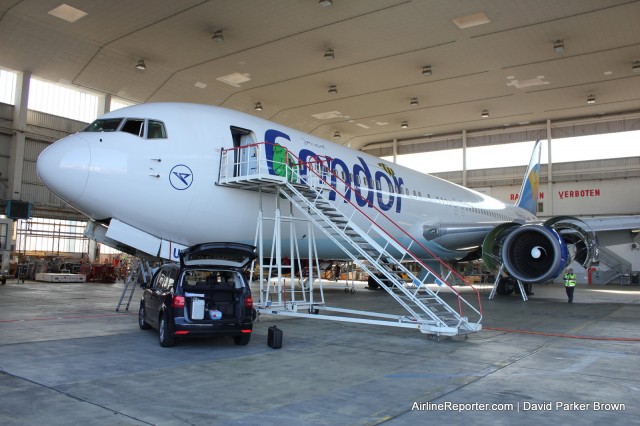
Condor Boeing 767-300ER being worked on in their maintenance facility
With Condor Airlines being a smaller, low-cost carrier, it is not a huge surprise that their on-site maintenance facility at Frankfurt Airport (FRA) is quite small (well, in comparison to others like Lufthansa Technik).
Just because the hangar might not have the volume of other locations, it is a place where the job gets done. Ensuring that aircraft are checked and safe is no easy task, but a very important one.
Condor’s facility at FRA is able to work on one Boeing 767 at a time — and they only work on their 767s and 757s there. Condor sublets out the work done on their Airbus aircraft at other facilities around Europe.
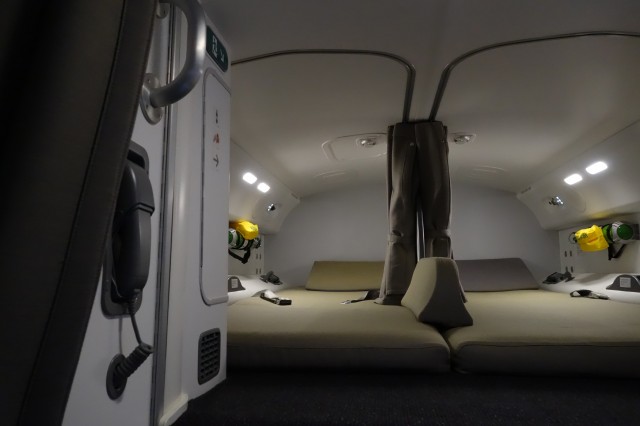
The pilot’s rest area inside an Air Canada Boeing 787 Dreamliner – Photo: Howard Slutsken | Airways News
Often passengers on long-haul flights do not stop and think about the need for the flight crew to rest. Pilots and flight attendants only have a certain number of hours that they can work, and then they need their time to rest.
Some airlines opt for crew rest areas either above or below the passenger cabin of the aircraft, while others will have crew just use your standard passenger seat.
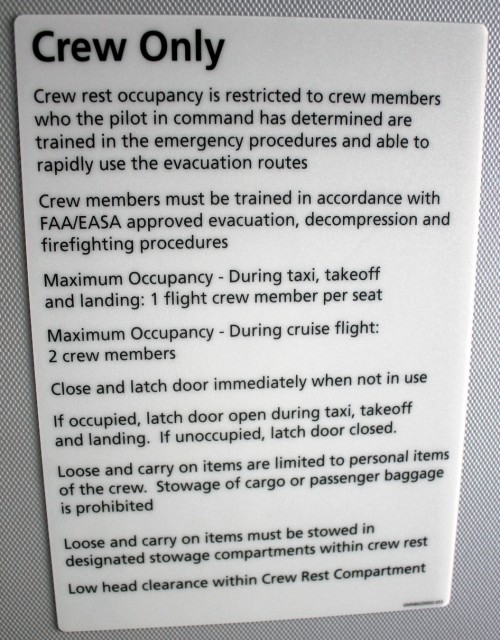
A crew rest sign means business – Photo: David Parker Brown | AirlineReporter
We have had a chance to visit quite a few different rest areas and I have to say that one thing that most of them have in common is they are small. They probably wouldn’t be a good fit for those who are claustrophobic.
It is not always easy to get to the rest areas (normally, steep stairs or a ladder), and once you are in, there isn’t always too much room to maneuver. However, what they do offer is a private space, away from passengers, to get some rest.
We wanted to share the number of different crew rest areas that we have visited. Enjoy the photo tour:
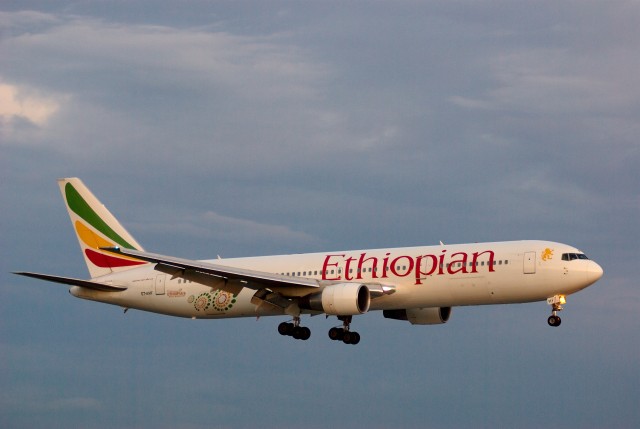
Photo of the Boeing 767 (reg ET-AMF) that was hijacked as flight ETH702 – Photo: Fabrice Clerc | Flicker CC
At 5:00pm Pacific Time, Ethiopian Flight 702, a Boeing 767-300 (registered ET-AMF) was flying over Sudan when it started squawking 7500. The transponder code, is supposed to indicate a “hijacking.”
Sometimes, pilots accidentally switch to this code or equipment malfunctions. This however, does not appear to be the case. The aircraft can be tracked live via Flightradar 24.
This was hopefully just an error, but this was certainly a deviation from normal flight.
We have reached out to a source who is an aircraft electrical expert and they confirmed that a “7500” code can’t come from a glitch.
The flight, operating from Addis Abba to Rome has been confirmed by Rome Airport not to have arrived yet. It is currently circling over Geneva Airport (GVA), with a military escort. Emergency crews are standing by a GVA.
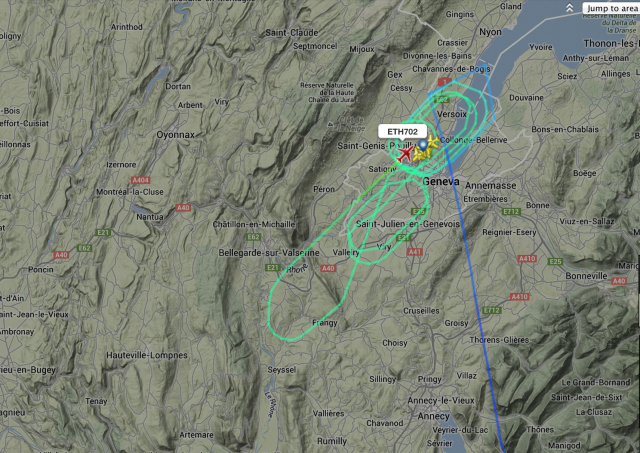
The unusual flight path the hijacked aircraft took prior to its safe landing – Image: Flightradar24
The aircraft landed in Geneva, safely, but with an extremely limited quantity of fuel remaining.
This story will be updated as details emerge.
We will also be live updating via twitter with #ET702
Ethiopian Airlines Press Release:
Ethiopian Airlines flight 702 on scheduled service departing from Addis Ababa at 00:30 (local time) scheduled to arrive in Rome at 04:40 (local time) was forced to proceed to Geneva Airport. Accordingly, the flight has landed safely at Geneva Airport. All passengers and crew are safe at Geneva Airport.
Ethiopian Airlines is making immediate arrangements to fly its esteemed customers on-board the flight to their intended destinations.
Once the press release went out to the public, the airline recanted it. Shortly it was re-released with minor changes.
UPDATES:
- The aircraft now has 20 minutes of fuel remaining (8:45pm PST) via LiveATC.net
- Reports of one engine potentially flaming out (unconfirmed via LiveATC)
- Reports of the aircraft being directed to make an approach but not landing until a response is given regarding the word “asylum” (via LiveATC)
- Fuel warning has been received on the flight deck (Via LiveATC)
- Aircraft apparently cleared for an ILS approach. What could be a hostage negotiator has been heard on the radio (Via LiveATC)
- Response to the request will be given by Swiss Authorities on Short Final for landing on Runway 05 (via LiveATC)
- AIRCRAFT HAS LANDED SAFELY (Via FlightRadar24 and LiveATC)
- Pilots heard on radio stating they will be exiting via the aircraft flight deck window. (via LiveATC)
- Airport/Airspace around Geneva is now closed (via LiveATC)
- Geneva airport remains closed (updated at 10:01PST)
- Unconfirmed reports the aircraft is parked at the end of Runway 05.
- Asylum request still pending. (9:33PST)
- International arrivals into Geneva are diverting to other airports (via FlightRadar 24)
- “We will disembark our passengers within the next 5 minutes and we will call you back.” Heard over LiveATC. (10:13pm PST) According to John Walton- this may actually have been regarding the arrival of BA723.
- Geneva Airport now saying that police are still negotiating with hijackers. (10:32pm)
- As of 10:42pm, there are unconfirmed rumors there is a lone hijacker.
- Geneva Airport Police confidently stating that no one has been hurt (10:45pm)
- Swiss Authorities stating that they have arrested the hi-jacker
- There is a press conference scheduled for 9:00am CET (12:00am PST)
- Swiss Police confirming that a pilot aboard the aircraft is the individual in custody (10:54pm PST)
- Signs of life on Geneva ATC are starting to be heard- normal airport operations are expected to resume shortly (10:56pm) (via Live ATC)
- News from the press conference indicates that it may have been the first officer that hijacked the aircraft (12:16am PST)
- The aircraft was apparently escorted by two Eurofighter Typhoons (12:20am PST)
- The co-pilot locked himself in the flight deck and was unarmed (12:27am)
- Regardless of where the hijacker is tried (either Geneva or Bern)- he is looking at a potential 20 year sentence.
- Back in 1996 an Ethiopian 767 had to ditch in the water due to hi-jackers and lack of fuel. Fight 961
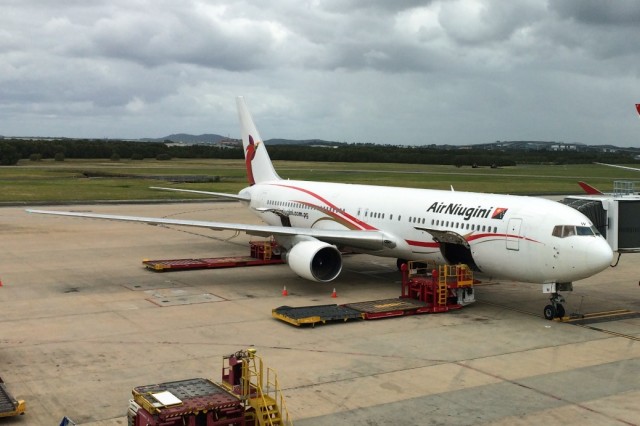
P2-PXV, a 767-383ER waiting for boarding at BNE – Photo: Bernie Leighton | AirlineReporter
So, you’re dumb enough to decide you want to go to Port Moresby on holiday? Well, first off, you are pretty dumb. Do you know how dangerous Port Moresby is? The American government clearly knows; they’re building a new fortress-embassy on the highway to the airport. This embassy construction site also houses all its workers behind three 20-foot high fences and a small contingent of Marines. Having said that, it is still safer than Lae! So, if you have to pick between the two…
It’s not an organized sort of crime, or resistance. It’s something more like a zombie movie. One target sees an opportunity and then, almost like a wave, the rest follows. From what I’ve seen, cricket bats are a popular weapon of late.
I suppose muggings and general mischief do take the edge off after the national pastime, chewing buai, was banned this year. Not that the other three activities were not popular before- they’re just all rather hard to do with a buai, and some mustard, turning your teeth and saliva bright red!
It is the most bizarre dichotomy, because at the same time, I have never met any people more welcoming, helpful, and friendly as the general Melanesians in the very same place.
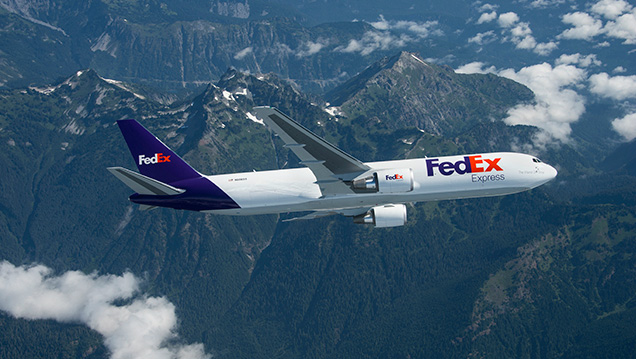
FedEx’s first Boeing 767. Image: Boeing.
FedEx Express (redundant, right?) is the air freight branch of the shipping and delivery giant, operating a massive fleet of airliners. These include DC-10s (also referred to as MD-10s), MD-11s, 777Fs, and now, their brand-new Boeing 767-300F. At a fleet count of over 300 ’œmainline’ aircraft (those narrow and wide-bodies not operated by feeders), how big is FedEx as an airline? Bigger than British Airways, Lufthansa, Emirates, ANA, Qantas, or US Airways. With a 50-plane backlog on the 767-300F, FedEx is taking drastic steps to modernize their fleet in the name of fuel efficiency and reliability.
The years of experience Boeing has in building and refining the 767 line has resulted in an airframe that satisfies the cargo mission very effectively. The 767-300F is based upon the 767-300ER passenger variant, with its upsized range, MTOW, and fuel capacity. FedEx expects a 30% fuel burn reduction compared to the DC/MD-10 models the 767-300F is replacing.






